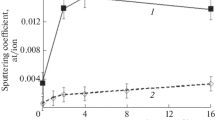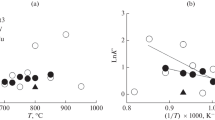Abstract
The evolution of indestructible blistering in molybdenum foils with the Mo {100} texture is investigated in dc glow discharge in a D2–N2 mixture with a nitrogen molar fraction in the mixture varying from zero to unity at 100 V potential negative with respect to plasma, a total pressure of 15 Pa, and temperatures of 30–60°C. After the addition of 0.01N2 to the deuterium discharge, the surface area occupied by the blisters increases from 2 to 5% and reaches its maximum of 11% upon exposure to D2−0.04N2 mixture discharge (the fluence is 4 × 1019 cm–2). Afterward, the area decreases, and blistering is absent in the pure N2 discharge. The amount of deuterium desorbed from the samples upon heating also increases with the addition of nitrogen. In accordance with X-ray photoelectron spectroscopy data, a nitride layer about 5 nm thick is formed if small amounts of N2 are added to D2. This layer is assumed to slow both the recombination rate of atomic deuterium coming from the material bulk to the surface and the transfer of D2 molecules into the gas phase. At the same time, the nitride layer increases the diffusion flux of D atoms into the foil bulk, promoting blister growth.








Similar content being viewed by others
REFERENCES
M. I. Guseva and Yu. V. Martynenko, Sov. Phys. Usp. 24, 996 (1981).
M. Kaminsky and S. K. Das, in Proc. 9th Summer School and Symposium on the Physics of Ionized Gases (Dubrovnik, 1978), p. 27.
V. Kh. Alimov, J. Roth, and S. Lindig, J. Nucl. Mater. 381, 267 (2008).
M. Balden, S. Lindig, A. Manhard, and J.-H. You, J. Nucl. Mater. 414, 69 (2011).
M. H. J. Hoen, M. Balden, A. Manhard, et al., Nucl. Fusion 54, 083014 (2014).
H. Skinner, A. A. Haasz, V. Kh. Alimov, et al., Fusion Sci. Technol. 54, 891 (2008).
A. R. Shugurov, A. V. Panin, and M. S. Kazachenok, Tech. Phys. 55, 1583 (2010).
A. S. Kuznetsov, M. A. Gleeson, and F. Bijkerk, J. Appl. Phys. 114, 113507 (2013).
N. V. Nikonov, Molybdenum. Properties, Application, Manufacturing, Products (Metotekhnika, Moscow, 2014) [in Russian].
C.-G. Oertel, I. Hünsche, W. Skrotzki, et al., in Proc. 17th Plansee Seminar (Reutte, 2009), Vol. 1, p. RM 16/1.
J. G. Che, C. T. Chan, W.-E. Jian, and T. C. Leung, Phys. Rev. B: Condens. Matter Mater. Phys. 57, 1875 (1998).
S. Okuda and S. Imoto, Jpn. J. Appl. Phys. 19, 971 (1980).
G.-N. Luo, K. Umstadter, W. M. Shu, et al., Nucl. Instrum. Methods Phys. Res., Sect. B. 267, 3041 (2009).
V. L. Bukhovets, A. E. Gorodetsky, R. Kh. Zalavutdinov, et al., Nucl. Mater. Energy 12, 458 (2017).
A. E. Gorodetsky, R. Kh. Zalavutdinov, V. L. Bukhovets, et al., J. Surf. Invest.: X-ray, Synchrotron Neutron Tech. 10, 1214 (2016).
J. Li, M. Shimada, Y. Zhao, et al., J. Nucl. Mater. 415, 35 (2011).
E. Carrasco, I. Tanarro, V. J. Herrero, and J. Cernicharo, Phys. Chem. Chem. Phys. 15, 1699 (2013).
K. Oura, V. G. Lifshits, A. A. Saranin, et al., Surface Science: An Introduction (Springer, Berlin, 2003).
I. Jauberteau, A. Bessaudou, R. Mayet, et al., Coatings 5, 656 (2015).
B. G. Demczyk, J.-G. Choi, and L. T. Thompson, Appl. Surf. Sci. 78, 63 (1994).
G. Ertle and N. Thiele, Appl. Surf. Sci. 3, 99 (1979).
O. V. Ogorodnikova, K. Sugiyama, A. Markin, et al., Phys. Scr., T 145, 014034 (2011).
R. D. Kolasinski, D. F. Cowgill, D. C. Donovan, et al., J. Nucl. Mater. 438, S1019 (2013).
Y. Ueda, T. Shimada, and M. Nishikava, Nucl. Fusion 44, 62 (2004).
S. Qin, J. Wang, L. Cheng, et al., Fusion Eng. Des. 129, 1 (2018).
ACKNOWLEDGMENTS
X-ray spectral microanalysis, as well as X-ray photoelectron and structural studies, was performed using equipment of the Joint Use Center of the Frumkin Institute of Physical Chemistry and Electrochemistry, Russian Academy of Sciences. The work was supported in part by the Presidium of the Russian Academy of Sciences (program no. I.34P).
Author information
Authors and Affiliations
Corresponding author
Additional information
Translated by S. Rodikov
Rights and permissions
About this article
Cite this article
Gorodetsky, A.E., Bukhovets, V.L., Zalavutdinov, R.K. et al. Blistering in Molybdenum Foils under Exposure to the Glow Discharge of D2‒N2 Mixtures. J. Surf. Investig. 12, 1052–1060 (2018). https://doi.org/10.1134/S1027451018050440
Received:
Published:
Issue Date:
DOI: https://doi.org/10.1134/S1027451018050440




